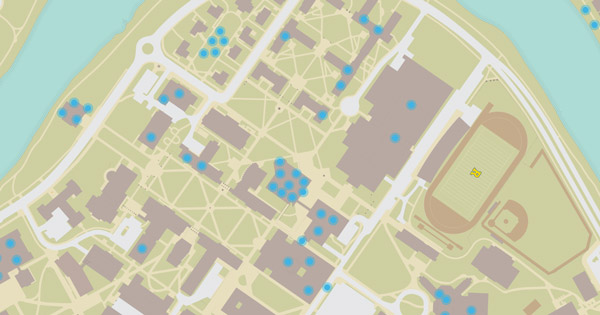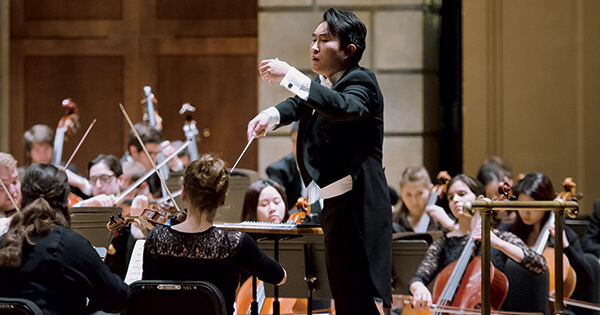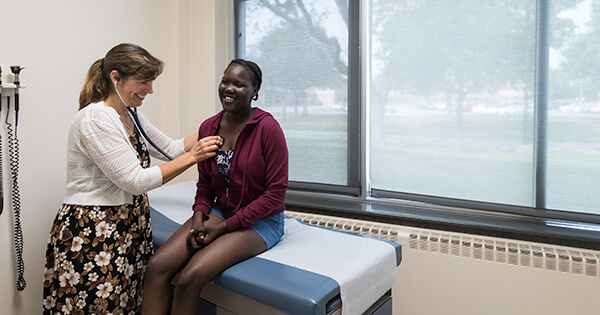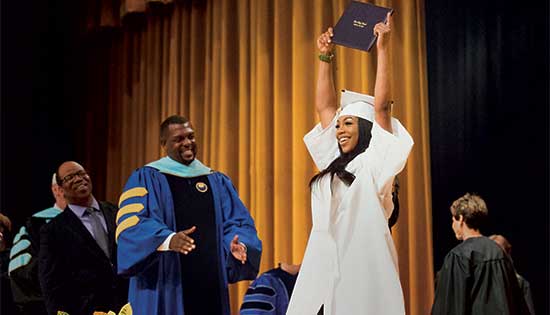Moving through space
Moving through space
For dancers and other performers, space is of critical importance—it is a bridge to expression and creativity. It is a vital link to nurturing the aesthetic needs of audiences. It provides both a foundation and backdrop for all those involved in a production to learn, grow, and connect.
“So much of what we do is not necessarily about performance but about self-awareness and trust/community building,” says Missy Pfohl Smith, director of the Program of Dance and Movement. “It’s about creating a private, safe space for personal and interpersonal expression and exploration. Having the right physical spaces to support this is so important.”
The River Campus lacks for space now. Rehearsal and performing venues are in high demand by departments, students, and clubs engaged in dance and movement, theater, and music. There just isn’t enough of it to go around.
Erin Dong ’18 knows this well. She recently completed a capstone project in which she combined her passion for and knowledge from both her majors—biology and dance—to create a dance called “The Beautiful Awful: Experiencing Grief through Movement.”
“In my senior project, I wanted to help people remember the loss they felt and experienced, connect to others who also shared that, and allow them to feel the emotions in their entire bodies, not just in their heads,” says Dong, who is now attending the University of Pittsburgh for a doctoral program in physical therapy.
Photo credit: Aaron Raymond
Dong worked on her senior project for months. With the help of her faculty advisor, dancer and instructor Anne Harris Wilcox, Dong knew that getting a leg up on space was essential. They talked about where she could rehearse and the pros and cons of each space, such as access to lighting, mirrors, seating options for audiences, and, of course, whether a space has sprung floors.
Sprung floors matter. A lot. They can mean the difference between a safe jump and a broken ankle. Sprung floors have “give” to them. They absorb shocks, improve performance, and reduce the likelihood of injury. So, they are good for ankles and joints and for jumping, twisting, and turning.
Many dancers will only perform on sprung floors. The River Campus has three studios with sprung floors: Spurrier Hall dance studio, the O’Brien Hall dance studio, and the Linda E. Sloan Studio in Todd Union. Although it doesn’t have a sprung floor, the May Room in Wilson Commons is a popular rehearsal and performance venue. It features a beautiful wood floor and a huge, wide open area.
With limited rehearsal and performance areas available, students often take what they can get. “I often recommend finding an open space, like a gym or racquetball court, even a dorm lobby, especially for rehearsals,” says Wilcox. “There just isn’t enough space around here to meet the growing demand.”
Classes get priority usage of a space. So do students like Dong who are working on their senior projects. For Dong, that meant that she had a key to Sloan Studio, allowing her and her dancers to rehearse when it worked best for them—even at 9 p.m. on a Thursday night or 8 a.m. on a Sunday.
Early on in her final semester, Dong knew she’d perform in Spurrier. Knowing this helped her design her capstone project. Because there would be little spatial distance between the dancers and the audiences, she choreographed what became a quiet, intimate performance that drew in the audience. Lighting was important part of her capstone, too, and, luckily, Spurrier is equipped to create the mood she wanted.
Both Dong and Wilcox agree on this: for them and many other performers, space is so much more than an actual physical area. Space comes alive through the creative interaction between performer and audience. Access to and the combination of the right type of floor, the right room temperature, the right lighting, and more, can facilitate inspiration, cultivate creativity, and create powerful energy.
Learn more about Dong’s capstone project here.
What makes a good dance space

Sprung Floor

Ample unobstructed area

Good ventilation

Room for a piano and/or drummer

Lighting options

Green room
(backstage space where performers prepare, wait, and/or warm-up)

Sound system options
for both live and recorded music

Audience seating options

Access to mirrors and/or a barre

Storage space
(so equipment doesn’t impinge on performing space)
What makes a good dance space

Sprung Floor

Ample unobstructed area

Good ventilation

Room for a piano and/or drummer

Lighting options

Sound system options
for both live and recorded music

Green room
(backstage space where performers prepare, wait, and/or warm-up)

Audience seating options

Access to mirrors and/or a barre

Storage space
(so equipment doesn’t impinge on performing space)
Create inspiration
Your generosity can help nurture the performing arts on the River Campus and support our students, faculty, and programming. Philanthropy plays an important role in making the construction of a vital new space happen, too. The 25,000-square-foot the Sloan Performing Arts Center will feature a black box studio theater, café, and more and is slated for dedication in the fall of 2020. For more information on how you can help, contact Ashley Smith, Senior Director of Advancement for the School of Arts & Sciences, at (585) 276-6561. You can also make a gift here.
—Kristine Thompson, June 2018





